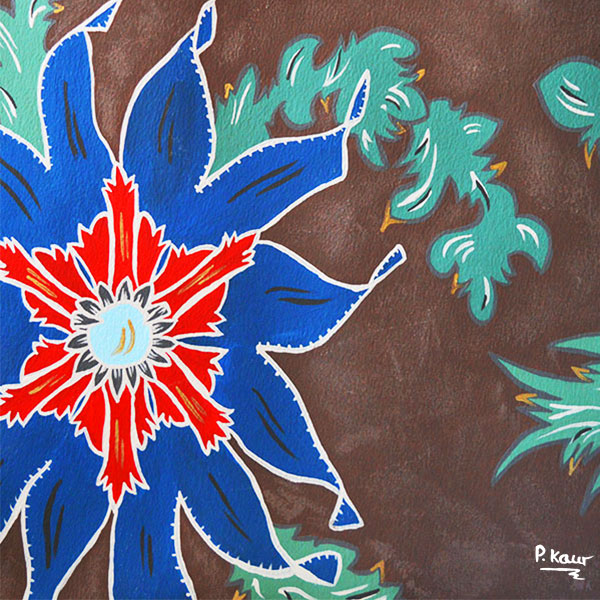The use of colour in decoration is the earliest examples we have of humans using colour intentionally. There has been evidence found in a cave of grinding pigments. This could have been used as body art or for early versions of cave art. It could have been used to decorate objects or homes. Evidence of this unfortunately hasn’t been found but we can assume to a degree.
Meaning of colour
We assign meaning, identify and purpose to everything whether physical or abstract, we are pattern seeking organisms. We assign a name and a purpose both of which tend to change with time and space. As time moves on, humanity learns new things, changes cultures, alters borders, innovates and so the meaning and purpose of things will change accordingly.
There is no exception with colour. The earliest civilisations were using basic colours like red, black and white which were derived from natural minerals like charcoal, iron oxide and chalk. Cave art suggests that the use of colour was in full flow. There likely were earlier experiments and early meanings allocated that haven’t survived the test of time.
We know that giant leaps without steps in between isn’t really possible in this world or existence in general. Evolution and existence has been built up over many small steps all building on top of each other.
Nature as inspiration
Nature is the first place we look for almost everything. Colour is vast in nature though some colours reign supreme. Early civilisations assigned names and meaning to the basic colours found in nature like green, black, white and red.
Many civilisations saw blue as similar to green because there aren’t many blue things in nature. Yes we have the sea and sky but in food, plants and animals, blue isn’t a common colour. Many civilisations and hunter gatherer tribes are able to discern many different shades of green, more so any other colour.
Red being related to fire is full of energy and is essence hot and dangerous. Black being the absence of colour and night, would have been somewhat scary with no light except the moon. And white, being this pure colour of clouds and certain minerals is pure and serene.
Assigning value to colours
As discoveries were being made, more colours were being used in society. The source of colours gave the colour a certain status or story. For example, Lapis Lazuli is the source of blue for ancient civilisations. It’s a deep blue metamorphic rock and was very valuable. To make paint from it was a lengthy process and this added value.
Red and purple became the colours of royalty in Europe due to the process of extracting the dye from the various natural sources. Red dye was made from cochineal scale insect which is native to the Americas. The process of harvesting, drying, grinding into a dye was lengthy and expensive. This made red only available to the wealthy. It’s a similar story for purple. Tyrian purple is made from sea snails and one gram of pigment needed 12,000 snails. Being so labour intensive, only the wealthy could afford it. Queen Victoria went further and declared that only she and her family could wear purple.
Assigning traditions to colours
Red is traditionally worn in the East by brides, but in the West, it’s white. Black is the mourning colour in the West but its white in the East. Black was also taken on by nuns in the Middle Ages as the colour to wear as it denotes seriousness and purity. Yellow was worn by early Emperors of China associating themselves with the sun.
Even countries have their distinct colours. Orange is the colour of the Netherlands while green is the colour of the Irish due to their political and religious history.
Colour related traditions do remain today while modern society has created new meanings for certain colours.
Colour in modern society
Due to scientific innovations, synthetic versions of all colours have been created. This makes colours cheaper and accessible to everyone in society and not just wealthy. The wealthy had to find new ways to flaunt their wealth and status, which we can discuss in another blog.
Modern society has its own fun moments with colour and how colours have been assigned to new things due to events and businesses claiming certain colours for their brands.
1812 – Brothers Grimm wrote a story about little red riding hood
1814 – the first yellow cab company in the US
1824 – Cadbury was founded, today with the distinctive purple colour
1840 – Queen Victoria wore white to her wedding starting a trend
1867 – yellow for the American suffragettes
1870s – blue demin along with Levi’s
1982 – coca cola founded with its red logo
1939 – ruby slippers worn by Judy Garland in the Wizard of Oz
1940 – mcdonalds with their yellow and red logo
1950s – pink is for girls
1960s – purple became associated with movement of hippies
2004 – facebook created with a blue logo
Green is now associated with environmental movements. Green is also envy in the West because of Shakespeare however envy is portrayed as yellow in France, red in China and purple in Japan.
Colour has evolved in human societies.
New discoveries allow new applications and greater variety of colour use. Scientists estimate there are around 10 million colours in the world. Given that there a few base colours, that is incredible. And as time goes on, new names, meanings and purposes will be given.





